|
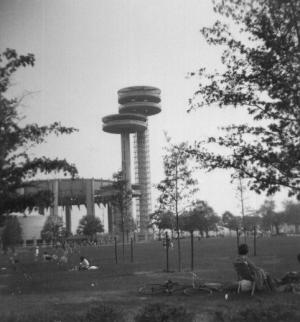
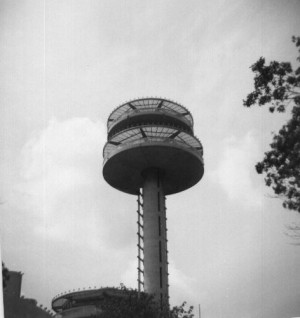
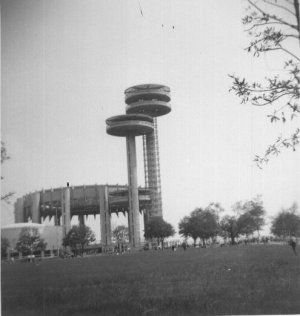
Opening Day, Restored Flushing Meadow-Corona
Park, June 1967
Source: Personal
Collection, © Copyright 2000, Charles Aybar
|
|
I worked at the park in the late 1960s
to early 1970s at the NYS Pavilion. I can tell you everything
about this building and the officials who visited it frequently.
In 1966, plans were to have this building
converted into an art museum for the NYS Arts Council. This plan
was successful. The "interior" walls were added then
(1966) to the main pavilion since most of them were left open
to accommodate a food concession facility during the Fair.
WHAT WAS ADDED INSIDE THE BUILDING: Track
lighting was added in the building by the area left of its main
entrance so that "art" could be displayed accordingly
inside. Drop ceilings and fluorescent lights were added to most
of the areas to the right of the main entrance and over by the
food area (by the big cement pots that had trees once in them).
The areas that were not touched (original Fair remnants) were:
1) The areas straight ahead of the main entrance and to the left
of it (the original "blue globes" were left hanging
from the ceiling, about 50 of them inside this one room. 2) The
restrooms (over by the staircase by the time capsules). 3) The
interior that once housed a cocktail lounge (left of the potted
trees with the glass exterior doors). 4) The dressing rooms (by
the extreme left of the main entrance).
CHANGES OUTSIDE THE BUILDING: Very few,
with the addition of new air conditioning units and a new tar
roof.
There were several art shows on display
for a couple of years, and one concert (I think it was the Byrds
that played there) held.
-
Charles Aybar
-
Posting to nywf64.com
Message Board
-
May 12, 2000
|
|
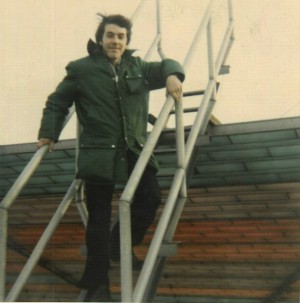
- Charles Aybar from the service column
(near the main entrance -- behind the Theaterama Building) on
top of the highest area (100 feet) to the access ladder onto
the roof (c. 1969). Note the thickness of the "sandwich"
effect of the roof panels.
Source: Personal Collection,
Copyright 2000, Charles Aybar
|
|
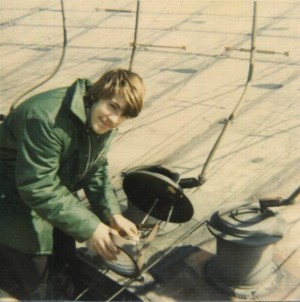
Charles replacing the 500 Watt GE Spot
Lights on the roof. These illuminated the map below and were
about 100 in number (these were in the middle "circle"
part of the roof).
Source: Personal Collection,
Copyright 2000, Charles Aybar
|
|
Walking on the roof of the Tent of Tomorrow...
Well, to be quite frank, I was scared to
death! At first, I would hold onto the upper cables (used for
lighting) and walk very gently. It took awhile to gain my confidence
that these panels could support my weight. I would have to replace
the light bulbs every now and then as well as bolt each one of
those panels together with an eyebolt that was strung from 100
feet below through a hole in the panel. Not an easy job -- but
hey, I was only a fearless teenager back then!!!
I remember once I stepped onto a panel
to see it vanish underneath me! I could have been killed if I
hadn't held onto the cable. Wow! How foolish I was back then.
When my parents found out what I was doing they nearly went hay-wire
and had a fit. But that didn't stop me from working there.
-
Charles Aybar
-
eMail to nywf64.com
-
July 19, 2000
|
|
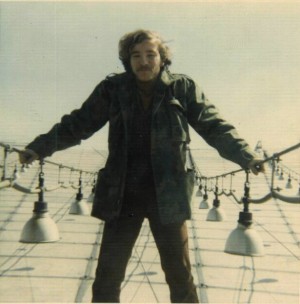
Charles' co-worker, "Atilla,"
walking on the roof guided by the lighting cables above the roof
panels.
Source: Personal Collection,
Copyright 2000, Charles Aybar
|
|
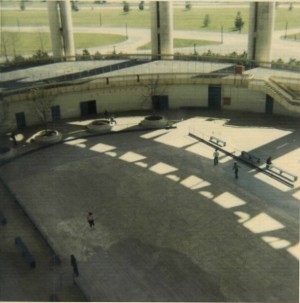
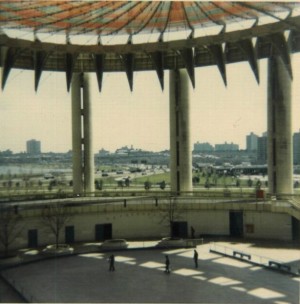
Looking down at the map from the column
access staircase.
Source: Personal Collection,
Copyright 2000, Charles Aybar
|
|
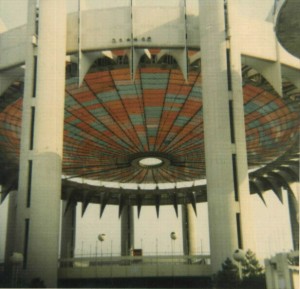
Main entrance photo. Note all the roof
panels were intact; "no thanks to my bravery installing
8" bolts through them" - Charles
Source: Personal Collection,
Copyright 2000, Charles Aybar
|
|
In the years 1969-70, Bob Jelen and his
wife Chris, both from Ohio, contacted the city to see if they
could open up a roller rink in NY. Since the city needed more
recreational facilities at Flushing Meadows, the NYS Pavilion
would be the obvious choice. The arts council did object to this
idea tremendously, but eventually caved in. After many concerns
from the arts council and the local civic groups about how the
preservation of the "Texaco Map" was to be treated
to prevent damage from skaters, it was agreed upon that the floor
be plastic coated. The roof (tent) was also a concern since some
of the panels started to flap in the breeze. A plan was developed
to secure them properly as well (I was one of the guys that worked
on that roof and was scared to death of falling through!) Parks
Department officials constantly visited the building at this
time to make certain all safety concerns were taken care of and
the building well preserved.
-
Charles Aybar
-
Posting to nywf64.com
Message Board
-
May 12, 2000
|
|
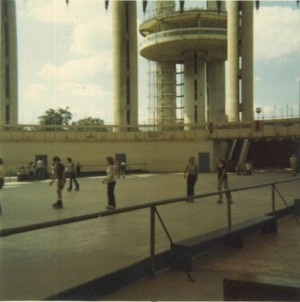
The floor was plastic coated to protect
the Texaco Map which allowed roller skating to take place.
Source: Personal Collection,
Copyright 2000, Charles Aybar
|
|
|
|
|
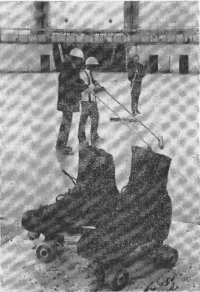
Keeping
New York State clean is a big, but not impossible task. Daily
maintenance helps preserve the New York State Pavilion's $1 million
floor.
|
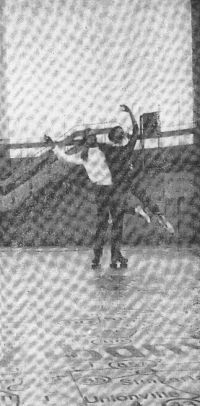
Skating's
fun for everyone.
|
'Roller Round' for LI
Skaters Will Take Over State Pavilion
|
By MICHAEL
DYER
|
The roof is dazzling in colors of blue, green gold and red.
It shields a map of New York State. The walls have been painted,
and a sign at the main entrance announces: "Roller Round
Skating Rink."
The scene is the New York State Pavilion at Flushing Meadows-Corona
Park. It is scheduled to open again March 17 as Queens' only
outdoor roller skating rink and, according to press releases,
the city's largest.
"It is a crime what is happening to the once-glorious
World's Fair buildings," said James Mosley, rink general
manager.
Mosley noted there had been talk of converting the State Pavilion
into a cultural center, but he pointed out the $11.5 million
facility has been used very little since the 1964-65 World's
Fair.
"New York City is already known as the cultural center
of the world," added the Manhattan resident. "On the
other hand it is also known to be lacking in recreational facilities
available to the general public. This is due to lack of space
and city funds.
"It is about time someone catered to the needs of the
majority."
* * *
MOSLEY SAID the rink's million-dollar
floor -- 31,000 square feet of terrazzo inlaid with a
|
unique map of the state -- will easily accommodate 1,000 persons
at a time.
Roller Round signed a three year lease with the City of New
York and will operate from March to mid-November each year. It
will pay back to the city a percentage of all receipts.
A transparent plastic coating has been applied to the floor,
according to Mosley, providing protection to the map as well
as a smooth, dust-free surface for skating.
The pavilion's roof, called the world's largest suspension
roof (106 feet high), was literally "flapping in the breeze"
before Roller Round engineers devised a method of bolting down
all those loose materials.
"The rink will provide a place for friends and family
to be together," said a spokesman for the firm. "They'll
have fun, exercise and even perhaps learn a little geography
while skating around the big, beautiful map of New York State."
The view is pretty nice too for roller skaters. The State
Pavilion is surrounded by the Unisphere, the New York City ice
skating building, ballfields and Shea Stadium.
There will be a $1 admission charge, and 35 cents extra for
skate rental.
|
|
Source: Long Island Post,
March 1970
|
|
|
|
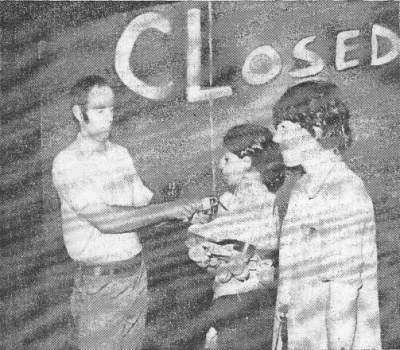
Concessionaire Robert
Jelen padlocks the roller rink as two former employees--Maria
Torrisi, 16, of Corona and Charles Aybar, 18, of Flushing--think
of better times. (Photo by Bob Weisenfeld)
|
ROLLER SKATERS SHUT OUT
City closes rink for 'hazardous' roof
|
By STAN
SOUSA
|
The wheels have stopped rolling at the Roller-Round Skating
Rink in Flushing Meadow Park.
There will be no more skating at Queen's only roller-skating
rink until "hazardous" roof conditions are corrected,
a spokesman for the city's Department of Parks, Recreation and
Cultural Affairs said yesterday.
The rink, housed in the New York State Pavilion Building built
for the 1964-65 World's Fair, was shut down Thursday because
the spokesman said the rink's operator, Robert Jelens, "had
not lived up to the terms of his contract which requires him
to keep the building in good repair."
Jelen, who said he was "caught by surprise" by the
shutdown, said he had been maintaining the rink at no cost to
the city since 1972 and "was never notified of any violation
from the city's Building Department."
* * *
HE SAID THE BUILDING department
told him the 1,000 multicolored plexiglass panels that make up
the roof are unsafe.
Jelen rents the 65,000-square-foot, 240-by-320 foot oval from
the Parks Department,
|
based on a percentage of gate receipts. He said it would cost
$50,000 to remove the roof paneling.
Jelen said he would pay for the roof's removal if the Parks
Department would forgive his rental payments until the $50,000
removal figure is reached. The panel is 100 feet high and slopes
down to walls 11 feet high that surround the rink, he said.
First, he said, he will meet Monday at 2:30 p.m. with Andrew
J. Jenkins, acting commissioner of the Building Department, to
see if removal of the roof and a guarantee by a professional
engineer of the rink's safety would satisfy the department.
Then, he said, he would have to negotiate the payments with
the legal representatives of the Parks Department.
* * *
JELEN SAID IF THINGS go well,
"the rink could re-open in three weeks." He said more
than 100,000 skaters use the rink annually, adding "we have
bookings from day camps, scout troops, and church organizations
throughout the summer."
|
|
Source: Long Island Post,
July 20, 1974
|
|
|
|
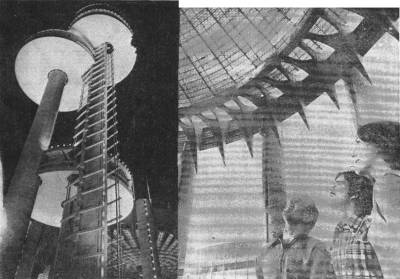
Robert Jelen, the
rink operator, left, David Oats and Jennifer Forbes, assistant
manager of the rink, look up at the missing panels in the roof,
which was once praised by architects, but is now the cause of
concern. (Photo by Ira Schwartz)
|
SKATING UNDER THE STARS?
Closed roller rink may go roofless
|
By IWEN
HSIAO
|
When and if the Roller-Round Skating Rink in Flushing Meadow
Park re-opens, it will probably be a roofless affair.
Housed in the old New York State Pavilion building of the
1964-65 World's Fair, the roller-skating rink was closed last
Friday because the city's Building Department found its roofing
conditions "hazardous."
H. Irving Sigman, Queens building superintendent, said the
vacate order was issued following an inspection which found 90
fiberglass roof panels missing.
Yesterday, following a meeting with acting Building Commissioner
Andrew J. Jenkins, Robert Jelen, the rink's operator, agreed
to remove the entire roof and hire a professional engineer to
inspect and vouch for its structural soundness.
|
The building department will rescind the vacate order once
its own engineer confirms the finding, according to the "understanding."
A spokesman for the building department said the department
will also study and evaluate all records relating to the building's
history and structure before reaching a decision on the building's
future.
Meanwhile, Jelen is also expected to negotiate with the city's
Parks Department, which has leased the building to Jelen since
1972, about how the estimated cost of $50,000 to remove the roof
paneling is to be paid.
Jelen said he would pay for the roof's removal if the Parks
Department would forgive his rental payments until the $50,000
removal figure is reached.
Some 100,000 skaters use the facility annually, according
to Jelen.
|
|
Source: :Long Island Post,
July 24, 1974
|
|
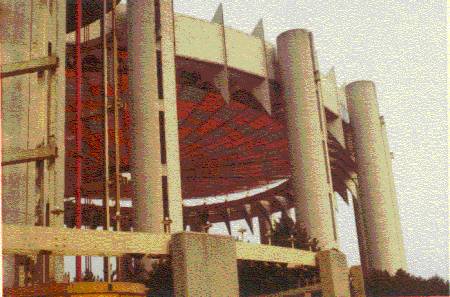
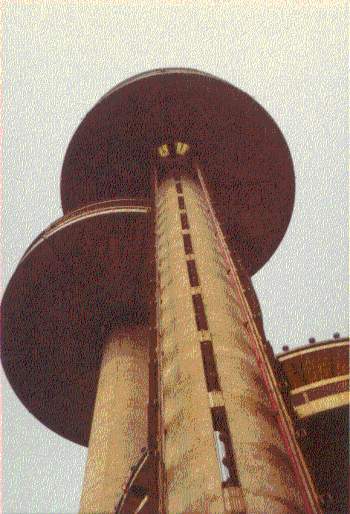
On a park walk-through, July 1975. Vandals
and souvenir hunters have already removed the decorative lighting
around the tower elevator entrance (top). The multi-colored fiberglass
panels still remain on the roof. The pavilion, by this time,
was abandoned. Note the canopy and decorative lighting still
remain on the lowest tower (bottom).
Source: Personal Collection,
Copyright 2000, Bruce Mentone
|
|
|